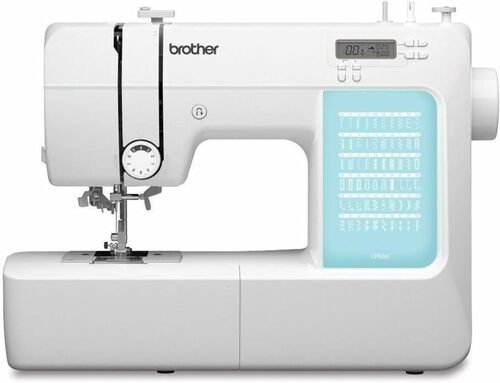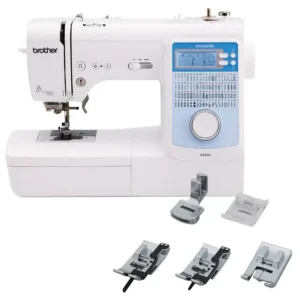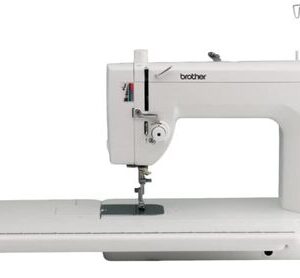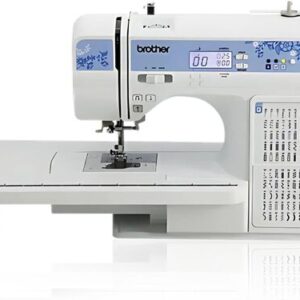
I still remember the morning the delivery guy set a compact brown box on my doorstep. I’d spent late nights scrolling through Brother CP60X computerized sewing machine reviews, trying to decide if this little workhorse could replace the clunky hand-me-down I’d been fighting with. I wanted something friendly, not fussy; a machine that would let me be creative without taking over the whole show. This is my honest Brother CP60X review — told like a story, because that’s how the machine entered my life.
Unboxing day
Under the tape and cardboard was a tidy setup: the Brother CP60X sewing machine, power cord, foot pedal, seven presser feet, needles, bobbins, and a real paper manual. That manual felt like a gift. No frantic searching, no “download this first.” I flipped to the threading page and breathed out — big pictures, numbered paths, step by step. The machine itself looked clean and modern with an LCD screen and a simple stitch chart. Light enough to lift with one hand, but not flimsy.
First stitches, first grin
I hadn’t bought a new machine in decades, so I treated the CP60X like a skittish cat. I filled a bobbin, clicked it into the drop-in case, and followed the etched guides. The needle threader took me a couple tries (it’s a two-step style) but once I got the rhythm, it saved my eyes a lot of squinting. I set the speed slider to turtle, pressed the foot pedal, and the motor purred instead of rattled. My very first seam — on scrap cotton — lay flat and neat. I might’ve done a victory lap around the kitchen.
Getting to know the 60
That first afternoon I played with stitches like a kid with new markers: straight, zigzag, blind hem, a couple of cute decorative leaves. The Brother CP60X computerized sewing machine offers 60 built-in stitches and seven buttonholes, and the screen tells you which foot to snap on. I loved that the stitches felt useful, not just “fancy for fancy’s sake.” I hemmed a pair of work pants, reinforced a tote handle, and stitched a quick patch on my kid’s jeans. Everything looked tidy and consistent.
Project #1: a “use it now” win
My first real project was simple — kitchen curtains. With the speed turned low and the Start/Stop button ready, I could guide those long hems without white-knuckling the fabric. The feed dogs marched evenly; no jumping, no bird’s nest. When I switched to a blind hem stitch, the LCD reminded me which foot to pick. It felt like having a calm sewing friend at my elbow.
Project #2: the thick-stuff test
I was brave the next weekend. Denim repair. I put in a size 90/14 needle, moved the speed up, and eased over the bulky seam. The CP60X climbed the “denim mountain” better than I expected for a compact machine. I learned to raise the presser foot and pivot before a big hump, and it walked right through. Not a single skipped stitch.
A hiccup or two (and how I fixed them)
Let’s be real — every machine has a personality. Mine gave me three tiny tests:
- The needle threader was fussy on very fine knits. I now thread those by hand or hold the thread a bit tighter when I use the lever.
- I got a couple of tangles early on. Turned out I’d missed one threading guide and my bobbin wasn’t evenly wound. I rethreaded from scratch, popped in a fresh bobbin, and the issue vanished.
- The built-in LED is okay but not stadium-bright. I added a little clip-on lamp and that solved it.
Another small surprise: the reverse tie-off is strong. If I tap reverse too long at the end of a seam, it’ll happily take a few extra backstitches. My habit now is two back, two forward — clean and secure.
Teaching moment
My niece (she’s twelve and fearless) asked to learn. We set the slider to slow, practiced on felt squares, and in an hour she had a gathered skirt. She loved the buttonholes — the CP60X makes neat one-step buttonholes once you set up the foot and place the button in the back gauge. Watching her confidence build was the best part of this whole Brother CP60X review journey.
Months in: what’s held up
I’ve put this machine through weekly projects: curtains, simple dresses, pillow covers, denim patches, and a stack of quilt blocks. The CP60X stays steady, especially on woven fabrics. On thick fleece I use a walking foot (bought separately) and a longer stitch length, and it behaves. I oil and clean as recommended (lint builds up faster than you think), and it keeps humming.
Customer-service reality check
I read enough Brother CP60X computerized sewing machine reviews to know some buyers ran into shipping dings or missing accessories. Mine arrived complete, but here’s my tip: open the box right away, even if you won’t sew for a while. Check that the accessory tray snaps on, the feet are there, and the handwheel turns smoothly. If anything’s off, deal with it while your return window is wide open. That’s not romance — it’s just smart sewing.
The day I almost blamed the machine
One afternoon my thread snapped eight times in a long seam. I groaned, then remembered the basics: new needle, correct size for fabric, quality thread, rethread upper path, reinsert bobbin. The culprit was cheap thread with weird slubs. Fresh spool, clean pass. Perfect stitching again. Lesson learned: the CP60X is honest — if it acts up, check your setup.
Little things I love
- The compact size — I can carry it from dining table to desk without a workout.
- The stitch chart is simple and logical; once you know your favorites, you tap the number and go.
- The speed control makes it friendly for beginners and precise for top-stitching.
- The presser feet snap on and off quickly; switching to a zipper foot mid-project is easy.
- The price made me feel like I got a “real” machine without a scary bill.
Things I wish were better
- A brighter built-in light would be great. (Easy fix: add a lamp.)
- The two-step needle threader takes a touch of practice.
- Very thick multi-layer seams still need good technique: proper needle, slow speed, and sometimes a hump-jumper.
Where it fits — and who it’s for
If you want a reliable, beginner-friendly, light machine that still gives you room to grow, the Brother CP60X sewing machine hits the sweet spot. It’s perfect for hemming, mending, home décor, light garment work, and learning the fun stitches without getting overwhelmed. If you’re planning daily heavy-duty leather or huge king-size quilts, you’ll want a bigger throat space and more horsepower — but for most of us, this is a happy place to sew.
Six months later — my honest wrap-up
I started this journey nervous. I’m ending it excited. I’ve made curtains that hang straight, a denim picnic blanket that survived the park, a dress with tidy buttonholes, and a quilt top that makes me grin every time I pass it. The CP60X made me feel capable, not clumsy.
If you’re hunting for a straightforward, real-life Brother CP60X review from someone who actually sews with it — here it is: this little machine turned my “maybe someday” list into finished projects. And here’s my final Brother CP60X review summary in one breath: the Brother CP60X computerized sewing machine is light, steady, beginner-friendly, and honest about what it can do; treat it well, use good needles and thread, and it’ll return the favor with clean stitches and fewer headaches.
Would I buy it again? Yes. It’s the sewing buddy that keeps pace with me — from cautious first seams to “let’s try it!” weekends — and it leaves my table (and my brain) a little tidier than it found them.
What real owners say in their Brother CP60X reviews?
| Pros (What customers like) | Cons (What customers dislike) |
|---|---|
| Beginner-friendly & easy to learn – Many say the Brother CP60X is simple to set up, intuitive to thread (after a short learning curve), and great for first projects, mending, and home décor. | Quality control variability – A noticeable minority reported DOA units, error codes on first power-up, missing accessories, or parts (e.g., storage tray clip, presser-foot holder). |
| Lightweight & compact – Easy to carry, store, and sew anywhere; still feels solid for its size. | After-sales/warranty frustrations – Some buyers struggled to get warranty support or had to pay out of pocket for diagnostics/repairs or shipping to service centers. |
| Good value for money – Multiple users compare it favorably to pricier models; strong “starter machine” for the price. | Lighting & visibility issues – Built-in LED described as dim; stitch icons/labels (white on light blue) hard to read for some, and one user expected a lit stitch panel. |
| Useful stitch selection – 60 built-in stitches, 7 one-step buttonholes; customers like the functional variety for everyday sewing (hems, patches, curtains, simple garments). | Needle threader can be finicky – Works for many after practice, but several say it’s tricky or ineffective—especially on fine knits or for tired eyes. |
| Smooth, quiet operation – Often praised as “smooth as butter,” with even feeding and tidy stitches on common fabrics. | Tension/feeding quirks for some units – A few report persistent tension problems, reverse stitching sticking “on,” feed dogs tangling, or the machine sewing backward (needed service). |
| Helpful guidance – Clear paper manuals (ENG/ESP), QR codes to short setup videos, LCD screen shows recommended presser foot. | Not ideal for thick stacks or specialty work – Can handle denim with proper needle/technique, but struggles on very thick layers; free-motion quilting led to thread breaks for some; walking foot and certain accessories can be harder to source. |
| Seven presser feet included – Users appreciate the out-of-box versatility for zippers, buttonholes, basic finishing. | Component/part complaints – Isolated reports of foot pedal intermittently cutting out, short spool pin causing thread spools to jump, or hand wheel binding after months. |
| Confidence-building for learners – Frequent success stories: hemming pants, Halloween costumes, quilt piecing, bag making—good “grow with you” machine. | Thread breakage with poor thread/setup – A few issues traced back to inexpensive thread, missed guides, or old needles; others experienced repeated breaks despite rethreading. |
Brother CP60X — Your Most-Asked Questions Answered
What is the Brother CP60X and who is it best for?
The Brother CP60X is a lightweight, beginner-friendly computerized sewing machine with 60 built-in stitches and one-step buttonholes. It’s great for first-time sewers and everyday projects like hemming, mending, home décor, and simple garments—an approachable choice if you’re researching a Brother CP60X review or comparing Brother CP60X computerized sewing machine reviews
How many stitches and buttonholes does the Brother CP60X sewing machine have?
The Brother CP60X provides 60 built-in stitches and 7 buttonhole styles (one-step). Stitch selection, width, and length are set from the LCD panel, which also shows the recommended presser foot.
Does the Brother CP60X have speed control and Start/Stop without the foot pedal?
Yes. The CP60X has a sewing speed controller (slider) and a Start/Stop button for pedal-free sewing. When the foot controller is connected, the Start/Stop button is disabled—use the pedal to run and the slider to set max speed.
What bobbin type does the CP60X use and how do I install it?
Use Brother SA156/Class 15 bobbins (11.5 mm high). The machine features a drop-in, quick-set bobbin: place the bobbin counterclockwise, pull into the slit, and the built-in cutter trims the tail so you can sew immediately.
How do I thread the Brother CP60X and use the needle threader?
Follow the numbered threading path: raise presser foot and needle, route through the guides and take-up lever, then into the needle. The built-in needle threader can be used with standard home needles (75/11–100/16) but not with twin/wing needles or heavy decorative threads.
Which needles and threads should I use for different fabrics?
As a guide: lightweight fabrics use 65/9–75/11 needles with 60–90 thread; medium fabrics use 75/11–90/14 with 50–60 thread; denim/canvas use 90/14–100/16 with heavier thread; knits use a ball-point 75/11–90/14. Always test on scraps before sewing.
Can the Brother CP60X sew with a twin needle?
Yes. Enable twin-needle mode, install the extra spool pin and twin needle (part code X59296-121), keep stitch width at 5.0 mm or less, and hand-thread both needles (the auto threader cannot be used). Always turn the handwheel to test clearance before sewing.
How do reverse and automatic reinforcement stitches work?
Press and hold the Reverse/Reinforcement button to lock stitches at the start/end of a seam, or enable automatic reinforcement so the machine locks at the beginning and end for you. The function depends on the selected stitch pattern.
How do I make buttonholes on the Brother CP60X?
Attach buttonhole foot A, set the button in the foot’s gauge (max buttonhole length about 28 mm, measured as button diameter + thickness), pull down the buttonhole lever, align the mark, and sew—the machine completes the one-step sequence automatically.
Does the CP60X support sewing on buttons and zippers?
Yes. For buttons, lower the feed dogs, attach button-sewing foot M, align the holes, match the stitch width to the hole spacing, and sew slowly. For centered zippers, use zipper foot I and straight stitch (center needle), topstitch around the zipper after basting.
What accessories come with the Brother CP60X, and what optional feet are available?
Included accessories vary by region but typically cover essential feet, needles, and bobbins stored in the flat-bed attachment. Optional add-ons include a walking foot (SA140), 1/4
How do I fix loose, tight, or tangled stitches on the Brother CP60X?
First, rethread completely (upper and bobbin) and return the tension dial to 4. Incorrect threading is the most common cause of loops, nests, or visible bobbin/upper thread on the wrong side. Clean the bobbin area if thread is tangled and test again on scrap.
Can I adjust decorative or satin stitches if they look bunched or gappy?
Yes. The CP60X provides a stitch-adjustment mode for certain patterns (e.g., satin/decorative). Use the stitch-length keys to reduce gaps (−) or relieve bunching (+), then test until the pattern looks right.
How do I clean and maintain the Brother CP60X sewing machine?
Unplug, remove the needle, foot, and needle plate, then lift out the bobbin case and brush lint from the race—do not use canned air. Reinstall the bobbin case aligning the marks. User oiling is not required or recommended; if the handwheel becomes stiff or noise occurs, contact an authorized service center.
Is the Brother CP60X a good value and are there any common complaints?
Based on customer feedback, many owners praise the Brother CP60X for ease of use, quiet operation, and value, especially for beginners. Common complaints include dim built-in lighting, a finicky needle threader for some users, and occasional QC issues (missing parts/DOA). If you’re reading a Brother CP60X review or browsing Brother CP60X computerized sewing machine reviews, check accessories on arrival and consider adding a task light for best visibility
Any quick safety reminders before I sew?
Always power off before changing needles/feet, keep fingers clear of the needle area, don’t pull fabric while sewing, and use only household AC within the rated range. Never operate with blocked air vents and keep the work area clean and stable.
| Specification | Details |
|---|---|
| Model | Brother CP60X computerized sewing machine (Operation Manual product code family: 888-N00/N02/N20/N22/N40/N42/N60). |
| Machine type | Computerized, household-use sewing machine with LCD operation panel and on-machine settings. |
| Built-in stitches | 60 built-in stitches (see machine’s Stitch Chart on Brother support site for the full list). |
| Buttonholes | One-step buttonhole sewing using buttonhole foot “A”; styles/sequence shown on the machine’s Stitch Chart. Max practical buttonhole length ~28 mm (button diameter + thickness). |
| Display & controls | LCD shows stitch no., recommended presser foot, stitch length/width, needle stop position, and single/twin-needle mode; keys for stitch/length/width adjustment. |
| Start/Stop & speed control | Start/Stop button and sewing speed slider available on models equipped with these features; foot controller overrides Start/Stop when connected. |
| Reverse/Reinforcement | Dedicated button for reverse/reinforcement; optional automatic reinforcement at seam start/end (toggle in settings). |
| Feed system | Standard feed dogs with rear feed-dog position switch to drop feed (e.g., for button sewing). |
| Free arm | Yes—remove the flat-bed attachment to use free arm for cuffs, hems, etc. |
| Bobbin system | Top-load drop-in “Quick-Set” bobbin with built-in cutter; use Brother SA156/Class 15 (11.5 mm high) bobbins. |
| Needles | Home sewing machine needles size 65/9–100/16 (ball-point recommended for knits); twin-needle compatible (part X59296-121) with twin-needle mode enabled and max stitch width ≤ 5.0 mm. |
| Thread range | General use with thread weights approx. #30–#90 (do not use #20 or heavier); match needle/thread to fabric per manual’s fabric guide. |
| Presser feet | Varies by region; machine indicates correct foot on LCD. Optional feet include Walking foot (SA140), Quilting foot (SA129), 1/4″ Piecing (SA125), Zipper “I”, Buttonhole “A”, etc. |
| Stitch adjustments | Length/width adjustable from panel; additional “stitch pattern adjustment” mode for satin/decorative/cross/quilting-stippling stitches. |
| Needle threader | Built-in needle threader (for sizes 75/11–100/16, not for twin/wing needles or some decorative threads). |
| Lighting | Sewing light turns on with main power (exact LED spec not listed in the manual). |
| Power | Household AC only; polarized plug in U.S.; use within rated AC range listed on the machine’s rating label. |
| Oiling | User oiling not required; do not oil. If stiffness/noise occurs, contact authorized service. |
| Cleaning | Remove needle plate and bobbin case to brush lint from the race; do not use compressed air. |
| Included documentation | Operation Manual (this document), Quick Reference Guide; Stitch Chart & Sewing Guide downloadable from Brother support site. |




